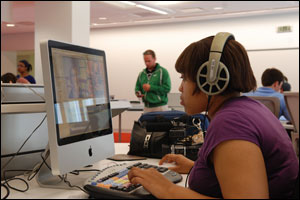Missouri Journalism Faculty, Students End Academic Year with Impressive Research Record
Productivity Includes 34 Journal Articles, 89 Refereed Papers, 9 Books and 16 Book Chapters
Columbia, Mo. (June 14, 2010) — Missouri School of Journalism faculty and students produced a striking amount and breadth of journalism and mass communications research in the 2009-2010 academic year.

Researchers discovered a range of significant and illuminating results. For example:
- Anti-tobacco TV ads that either frightened or disgusted viewers – but not both – had the biggest effect.
- Men had more ease reading news stories written in a chronological structure, while women appeared to do equally well regardless of story structure.
- Chinese correspondents stationed in the U.S. feel conflict between their responsibilities as professional journalists and their Chinese patriotism.
- People had a more pleasant facial expression when looking at friends’ pages on Facebook than when browsing CNN or Amazon Web pages.
- Public relations practitioners ranked seventh in ethical and moral development among 19 professions studied – behind seminarians, philosophers, and some health professionals but well above the lowest-ranked groups: junior high school students and prison inmates.
Missouri journalism faculty and students published 34 journal articles, presented 89 refereed papers at conferences, and wrote nine books and 16 book chapters in the past 12 months.
In addition, Missouri journalism placed first among U.S. advertising and strategic communication programs in the number of scholarly publications during the past 10 years, according to a study presented at the American Academy of Advertising.
Among this academic year’s research topics:
Privacy and Freedom of Information
- Why we need increased camera presence in courtrooms
- Strategies for acquiring public records
- Privacy issues with online court records
International Journalism
- How well U.S. news organizations cover Asia
- U.S. and South Korean coverage of North Korean nuclear tests
- How Chinese foreign correspondents in the U.S. see their role
Politics
- Editorial cartooning of the 2008 U.S. bailout bill
- Animated Web cartoons, negative blogs, and televised satire during the 2008 presidential election
- International students’ views and participation in the 2008 presidential election
Business
- How Fortune 100 companies approached the “About Us” pages on their websites
Religion
- A critique of religion coverage in the 1990s
Public Relations
- Moral development of public relations practitioners compared with that of other professions
- How Duke University handled public relations during the 2006 lacrosse team crisis
- Whether public relations professionals’ facilitation of scientist-journalist discourse improves news accuracy
Advertising
- Why people pass along certain online video ads
- Why some viral advertising is more effective than others
Health
- The effectiveness of graphic anti-tobacco and other public health ads
- Health journalists’ dedication to covering health issues
- Computer communication among patients with chronic illness
New and Legacy Media
- How users emotionally respond during Facebook sessions
- How citizen journalism websites compare with legacy news organization sites
- How newspaper newsroom cutbacks affect profitability
- A comparison of U.S. and Chinese Web pages
History of Journalism
- An historical case study highlighting the potential corruptibility of news, advertising, and circulation sides of the media.
- Images can illuminate history in ways other artifacts and documents cannot.
- How Walter Lippmann, A.J. Liebling, and I.F. Stone became part of the story in coverage of Arab-Israeli conflicts
- American Civil War soldiers’ media dependency on print media
- The revolution in magazine publishing from 1880-1920
Gender Issues
- How men and women read news differently
- The effect of gender in organ donation sponsorship
Journalism Education
- Journalism ethics
- Attitudes among journalism students from different cultural backgrounds
- The effectiveness of using the Missouri Journalism teaching model in China
Photojournalism
- Photography of 1930s Georgia chain gangs
- Photography of sex workers in Bombay
- How digitizing photographic archives at U.S. newspapers may change historical records
Updated: May 12, 2020